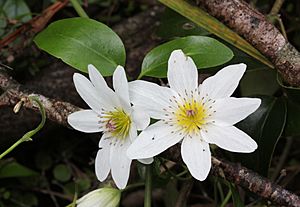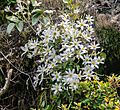Clematis paniculata facts for kids
Clematis paniculata (in Māori puawhananga) is a type of flowering plant in the buttercup family called Ranunculaceae. It is one of seven kinds of clematis plants that grow naturally in New Zealand. C. paniculata is the most common of these and can be found widely in forests across the country.
This plant grows from low areas up to low mountain forests. It blooms with flowers between August and November.
The Māori name puawhananga means “flower of the skies.” Traditionally, when it flowered, it signaled the start of spring.
Quick facts for kids Clematis paniculata |
|
|---|---|
 |
|
| Scientific classification | |
| Synonyms | |
|
Contents
Description
Clematis paniculata is an evergreen plant. This means its leaves stay green all year. It is a woody vine that climbs high. Its main stem is usually about 10 centimeters (4 inches) or more wide at the bottom.
The leaves are dark and roundish. They have few hairs underneath and strong small branches. The edges of the leaves can be toothed, smooth, or slightly lobed near the top. The leaves feel like leather, so you can see small pores and wrinkles. They look shiny and tough. The leaves are shaped like a wide oval or oblong, and they are heart-shaped at the base.
Clematis paniculata is a unisex plant. This means it has separate male and female plants. Both male and female flowers look similar. They both have six white sepals, which are like petals. However, the female flower has smaller sepals than the male. Both have white sepals that are narrow towards the end, or have a rectangular or rounded end. Female flowers have only a few small stamens (parts that produce pollen), while male flowers have many. Female plants produce hairy achenes, which are small dry fruits, about 2–4 millimeters long.
Where it Grows
Clematis paniculata is native to New Zealand. This means it naturally grows there. It has also started growing on the Chatham Islands. You can find it all over the North, South, and Stewart Island.
Habitat
C. paniculata lives throughout New Zealand. It is found in lowland and subalpine forests. You can see it from coastal areas up to lands between 300 and 800 meters (about 980 to 2,600 feet) above sea level. It grows in tall forests or shrubland areas.
Ecology
Life Cycle
The Clematis paniculata plant goes through different stages during the year. It flowers from August to November. It then produces fruit from October to January. Its flowers are unisexual, meaning there are separate male and female flowers. Male flowers have a stamen, which is the part that makes pollen for the plant to reproduce.
The seeds of Clematis paniculata are easily spread by the wind. They are found in a silky, feather-like cluster. The seeds usually sprout within 2–3 months, but this can sometimes be unpredictable.
What it Needs to Grow
Clematis paniculata likes soil that is damp but not too wet. If its roots get too dry, the plant will not survive. It prefers a balanced moisture level.
Since clematis is found in lowland areas, it often grows in brown soil. This is the most common type of soil in New Zealand. It also grows up mountains and into moist lowlands. In the northern North Island, it might be found in granular soil. This soil comes from volcanic material that has broken down over time. Clematis prefers soil where summers are not too dry and winters are not too waterlogged. This gives the plant the perfect dampness it needs to grow well.
Clematis paniculata likes sunny spots. The vine will climb up other trees to reach the sunlight. However, it does not do well in very humid climates. In humid conditions, it can easily get a disease called powdery mildew.
Friends and Foes
What Feeds on Clematis paniculata
The Clematis paniculata is a favorite plant for the honey bee to visit for pollen. Bees help the plant reproduce.
Different Kinds of Rusts
There are four types of endemic rusts that affect Clematis paniculata in New Zealand. One of these is Aecidium otagense. This rust is the most harmful because it can cause the flowers, leaves, and stems to become deformed. The changes it causes to the flowers and stems can look very dramatic.
Another interesting rust is Puccinia alboclava. This rust only affects C. paniculata and no other kind of Clematis species. Puccinia alboclava is found on the soft leaves of young Clematis paniculata plants. It has only been found to infect Clematis paniculata in Dunedin and the center of the North Island. This rust produces colorless spores on the plant. This is a very rare type of rust and seems to be the first to do this on a clematis species.
Cucumber Mosaic Virus
The Cucumber mosaic virus is a virus that has been infecting Clematis paniculata plants. This has happened in lowland forests near Dunedin. The virus has caused a big drop in the number of Clematis paniculata plants. It is very dangerous to Clematis paniculata because it can infect the plant itself. It can also infect the trees that the clematis uses for support.
The virus causes several problems for the plant. These include small damaged areas, yellow spots, ring-shaped spots, tissue death, early leaf fall, and twisted leaves. The virus is spread from plant to plant by aphids. Aphids can carry the virus in different ways. For example, the virus can stay active in an aphid for long enough for the aphid to move to an uninfected plant. Aphids can infect many (up to 39) healthy plants within 10 minutes after touching an infected plant. This is why Cucumber mosaic virus is so harmful to plants, as aphids can spread it quickly and easily.
Cultural Uses
Clematis paniculata, also known as Puawananga in Te Reo, is very important to the Māori community. It has great cultural meaning for many reasons.
One main reason is that it is part of their legends. Many tribes believe that Puawananga and Whauwhapaku are the children of Puanga (Rigel) and Ruhua (Antares). Puanga is the brightest star in the Orion constellation. Ruhua is the brightest star in the Scorpion constellation. When these two stars rise in the morning, it signals that summer is coming. The time between June and November, when these events happen, is also when the Puawananga flowers bloom.
Māori also use the flowering of the plant as a sign that spring has begun. It also means that eels have started to move up the rivers to lay their eggs. So, it was time to harvest the eels. This spring event matched the blooming of the flowers. Women would also use Puawananga to make beautiful wreaths and garlands for their hair.
There are also records that past Māori ancestors used Puawananga for medical purposes. Women would use it for various issues. These included general blood problems, skin rashes, kidney troubles, and bleeding. They would use the leaves to create blisters as a way to relieve pain. The sap was used to help heal wounds. Puawananga was only used by women. They would take it three times a day before meals.
No Similar Plants
Something special about the Clematis paniculata is that there are no other plants quite like it in New Zealand. This is true whether they are endemic (only found there), native, or introduced. Nothing else has the same dark green leaves, leathery texture with a smooth edge, and unique white flowers. It is the only species in New Zealand that fits all these descriptions. This is what makes it so unique and special, along with being a native plant.
See also
 In Spanish: Clematis paniculata para niños
In Spanish: Clematis paniculata para niños




